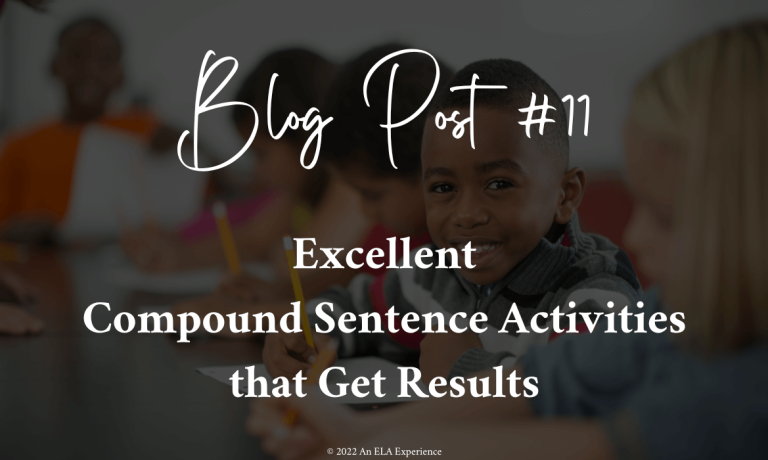Compound sentence activities can be engaging and interesting. In fact, I dare say that most of my students enjoy learning about commas and semicolons. It’s like I open a magical portal to the unknown, a place they heard of but don’t quite understand, and I can help them solve this punctuation mystery. When they come to me, they know that a comma is used in a sentence, but they aren’t sure exactly where to put it. So, when I explain, they actually listen, and when I assign an activity, they participate.
If you haven’t read my first blog, “Easy Introductory Activities for Teaching Students How to Use the Comma,” then do so as soon as possible. It explains how to begin teaching students how to use commas in sentences, and it offers free resources–warm-ups, a slideshow (starring Max, one of my dogs), and anchor charts (including one for commas with compound sentences).
That’s where I begin–with an overview of five rules for using commas in sentences (commas with items in a series, commas with compound sentences, commas with openers, commas with interrupters, and commas with closers). This gives students an overview of the rules we will be studying.
Activities for Introducing Compound Sentences
Compound Sentence Anchor Charts
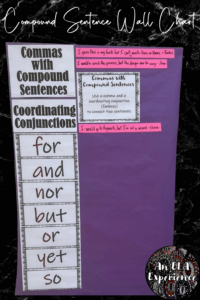
Anchor charts are easy, easy for teachers to set up and easy for students to refer to when needed, so let’s start here.
Grab a piece of butcher paper, and write the following on it:
- a title (e.g., Commas with Compound Sentences)
- the rule (e.g., Use a comma and a coordinating conjunction to connect two sentences.)
- the mnemonic fanboys to remember the coordinating conjunctions (e.g., for, and, nor, but, or, yet, so).
Tape it to your wall, and you’re ready to go. Now, whenever your students are completing the “Compound Sentence Activities for Practice” below, draw stars (or any positive symbol) next to the best sentences, and have students add their sentences to the chart (on sentence strips or directly on the chart). Also, if you take the time to make your chart look pretty and professional, then laminate it so you can use it again next year.
I direct my students to write their sentences on sentence strips whenever they see stars on their papers. I draw these stars in the margins when they’re working or I’m grading. When handing papers out, I remind them to keep an eye out for the stars. (I like the idea of killing three birds with one stone–praising students, returning papers, and getting exemplary sentences on my anchor charts, in this case.)
Let the Compound Sentence Teaching Begin!
After my wall charts are hung, I start teaching commas with compound sentences. Now, you may notice that I referred to commas with items in a series above. I do touch on this with warm-ups, but I quickly move on to compound sentences because the vast majority of my middle school students correctly use commas with lists. This is one comma rule they know. I may have one or two a year who don’t, and I conference with them individually. I also like hitting compound sentences early because students need to review independent clauses, and these provide the perfect opportunity to do that.
Compound Sentence Slideshow
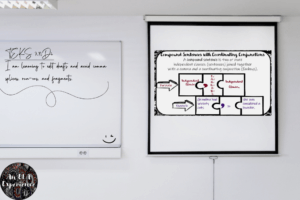
My first compound sentence activity includes a direct teach. Using a slideshow or a sheet of paper and a document camera, discuss compound sentences with definitions and examples.
Definition
A compound sentence uses a comma and a coordinating conjunction (fanboys) to connect two sentences.
Example Sentence
Grandma had seventy cats, so she was considered a hoarder.
Make sure to point out the comma and the coordinating conjunction, and note that the sentences on both sides of the coordinating conjunction are independent clauses. They are complete sentences, so they can stand alone (or they can be combined to form a compound sentence).
Teach students to check the sentences by identifying the subjects and verbs and ensuring that a complete thought is expressed. In the sentence above, Grandma is the subject and had is the verb in the first part of the sentence, and a complete thought is expressed. In the second part, she is the subject and was is the verb, and a complete thought is again expressed.
Simple Versus Compound Sentences

Sometimes sentences will resemble compound sentences, but when dissected, they may be missing a subject after the coordinating conjunction, for example, so they are actually simple sentences. If the sentence reads Grandma had seventy cats and was called a hoarder, then no comma is needed because the second part of the sentence (after the coordinating conjunction and) is not complete. When taken alone, it’s missing the subject (she). I discuss this with students too because they will want to add a comma before the word and when learning.
Compound Sentences with Semicolons
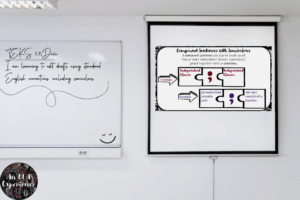
I also use this time to introduce students to the semicolon because it too can be used to form a compound sentence. Let students know that instead of using a comma and coordinating conjunction, they can use a semicolon.
Example
Grandma had seventy cats; she was considered a hoarder.
Let’s Cheer for the FANBOYS, and Let’s Talk in Compound Sentences.
To make this presentation engaging and the fanboys memorable, I sprinkle in a couple of ideas from Jeff Anderson’s Everyday Editing (an excellent resource) into our slideshow presentation.
One of these compound sentence activities is chanting the fanboys, a mnemonic that will help students remember the coordinating conjunctions–for, and, nor, but, or, yet, so. Instead of chanting, my students and I cheer. (Girly girl here.) For example, I’ll say, “Give me an f,” and they’ll respond with “for.” We’ll do this today and a few more times while studying compound sentences because memorizing this mnemonic will help students master this rule.
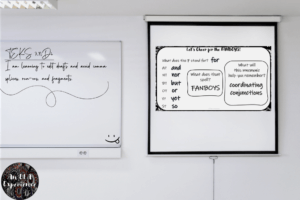
We end this lesson by talking in compound sentences for the rest of the class period. I begin by giving students directions in the form of compound sentences: “Let’s talk in compound sentences, for it will be fun. I am the teacher, so I will start. Speak only in compound sentences, or don’t speak at all.” I turn any simple sentences I need to say into compound sentences by joining them together with coordinating conjunctions and directing my students to do the same.

Compound Sentence Activities for Practice
Students need plenty of practice to master commas in compound sentences, so here are a few ways I provide them with that practice.
Compound Sentence Warm-ups with Mentor Texts
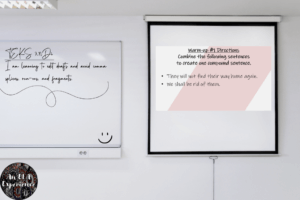
I create warm-ups for students where they combine, imitate, and write sentences. I usually use mentor texts we read in class to make these, but since I’ve been selling them on Teachers Pay Teachers, I’ve started collecting them from books published before 1923 because of copyright laws. Still, in class, you can find great sentences from any literature you’re reading, especially compound sentences. They’re everywhere.
Say you’re reading A Christmas Carol, for example. As you read, make abbreviated notes in the margins of sentence types that you come across. I write CC for compound sentences with coordinating conjunctions and ; for compound sentences that use semicolons. When typing the warm-up, separate the sentence into two sentences. For example, Dickens’s “Keep Christmas in your own way, and let me keep it in mine” would be broken up like this:
- Keep Christmas in your own way.
- Let me keep it in mine.
Next, direct your students to combine the two sentences using a comma and a coordinating conjunction.
When you study a particular comma rule, these sentences will start standing out in your reading and even the music you listen to.
Compound Sentence Collecting

It’s beneficial for students to collect sentences too. Have them work in groups or individually to look for compound sentences and present their sentences to the class for discussion. Is it a compound sentence? How do they know? Does it include two sentences joined by a semicolon? A comma and a coordinating conjunction?
Direct them to note these sentences in their writers’ notebooks on a page dedicated to compound sentence collecting. They can write their sentences directly on the page, on sticky notes attached to the page, or on a pretty handout as shown above. 🙂
When planning for this assignment, choose shorter texts that you know include compound sentences, and if students are having difficulties finding one, then direct them to a specific page or paragraph.
Compound Sentence Scramble Activity
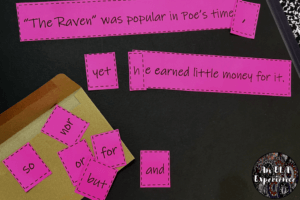
This compound sentence activity allows for movement and collaboration. Using a large font, type mentor sentences onto a document in four chunks: sentence one, a comma, the second sentence, and a period. Also add the seven coordinating conjunctions to the page (for, and, nor, but, or, yet, so). Print them in different colors so you can easily separate them accordingly if needed (and not mix up your sentences). Make each sentence a station, and instruct students to construct compound sentences as they rotate through the stations. Challenge students further by bringing in semicolons or compound sentences that include more than one sentence.
Compound Sentence Worksheets and Task Cards

Both worksheets and task cards will allow students to practice. (I prefer task cards because of student engagement; however, I also know there’s often that one class who works better when they stay seated.)
If you’re using a worksheet, consider playing some music and/or allowing students to work with partners. (After all, collaboration is one of the four Cs of engagement.)
For task cards, I tape them around the room (ten or more for a class of thirty), play some music, and have students work collaboratively at each station.
If you want to create your own worksheets or task cards, here are a few ideas:
- As with warm-ups, ask students to combine, imitate, and write sentences.
- Add some test prep by taking the compound sentences and adding spelling, capitalization, usage, and punctuation errors as they do on state exams. (I use only a few of these because we want students to see correct examples.)
- Have students determine whether the sentence is simple or compound.
- Add a brain bonus where you ask students to find as many words as they can in another word or two (compound sentences, for example).
Compound Sentence Activities for Reflecting and Assessing
Exit slips
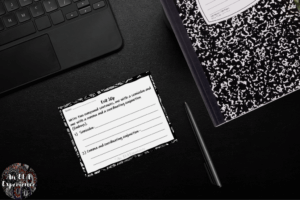
I’m an exit slip fan. They allow for closure, a quick assessment, and an opening to the next lesson. Plus, they’re simple to incorporate. Just give students index cards, have them write their names on them, and ask them to respond to a prompt:
- Why is it important to use commas correctly?
- Write a paragraph that includes and underlines a compound sentence.
- Write two compound sentences, one with a semicolon and one with a comma and a coordinating conjunction.
After collecting students’ exit slips, read through them and note which ones you’d like to open your next compound sentence warm-up or lesson with (for review or clarifying misconceptions).
Quiz
Use a worksheet as a quiz for assessment. When grading, notice what questions students had difficulties with and review those with them.
Apply to Writing
Students need to apply what they learn to their writing. That’s the true test. Whatever they’re writing (e.g., readers’ responses, writers’ notebook entries, first or final drafts of essays, short-answer question responses, etc.) have them underline a compound sentence in their writing. If they don’t have one, they can add one or combine two sentences to create one.
Related Links
Easy Introductory Activities for Teaching Students How to Use the Comma discusses how to teach students to use commas in sentences and includes free resources.
Compound Sentences Practice includes a quiz, exit slips, a manipulative, worksheets, writers’ notebook pages, and a compound sentence slideshow from my TPT store.
Khan Academy’s “Simple and Compound Sentences” is a student-friendly video that explains simple and compound sentences.
Grammarbook.com’s “Compound Sentences: What is a Compound Sentence?” explains what a compound sentence is with examples.
Compound sentence activities might sound like a lot of work, but they really aren’t. The warm-ups, exit slips, sentence collecting, and applying-to-writing activities can be done in five to ten minutes. Other than that, I spend one forty-five-minute period on the introduction to compound sentences and another on a practice activity. (Then we move on to complex sentences.)
In a Nutshell, Here’s How to Teach Compound Sentences:
- five-minute daily warm-ups for six weeks (three for commas with coordinating conjunctions and three for semicolons and commas with coordinating conjunctions)
- one direct teach with cheering for the fanboys and talking in compound sentences
- one or two practice activities (task cards, worksheets, sentence scramble)
- a sentence collection page (added to any reading time–silent, partner, or group)
- one or two five-minute exit slips
- application to writing (when students are writing anyway)
Thank you for reading! I hope you and your students enjoy these compound sentence activities!

